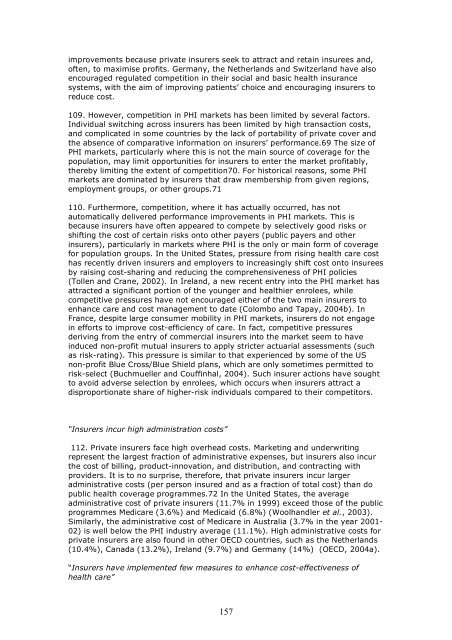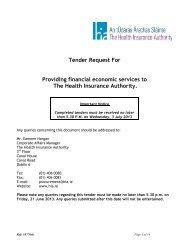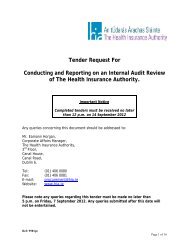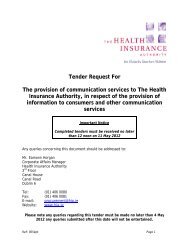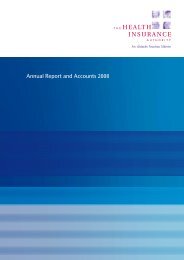Competition in the Irish Private Health Insurance Market
Competition in the Irish Private Health Insurance Market
Competition in the Irish Private Health Insurance Market
You also want an ePaper? Increase the reach of your titles
YUMPU automatically turns print PDFs into web optimized ePapers that Google loves.
improvements because private <strong>in</strong>surers seek to attract and reta<strong>in</strong> <strong>in</strong>surees and,<br />
often, to maximise profits. Germany, <strong>the</strong> Ne<strong>the</strong>rlands and Switzerland have also<br />
encouraged regulated competition <strong>in</strong> <strong>the</strong>ir social and basic health <strong>in</strong>surance<br />
systems, with <strong>the</strong> aim of improv<strong>in</strong>g patients’ choice and encourag<strong>in</strong>g <strong>in</strong>surers to<br />
reduce cost.<br />
109. However, competition <strong>in</strong> PHI markets has been limited by several factors.<br />
Individual switch<strong>in</strong>g across <strong>in</strong>surers has been limited by high transaction costs,<br />
and complicated <strong>in</strong> some countries by <strong>the</strong> lack of portability of private cover and<br />
<strong>the</strong> absence of comparative <strong>in</strong>formation on <strong>in</strong>surers’ performance.69 The size of<br />
PHI markets, particularly where this is not <strong>the</strong> ma<strong>in</strong> source of coverage for <strong>the</strong><br />
population, may limit opportunities for <strong>in</strong>surers to enter <strong>the</strong> market profitably,<br />
<strong>the</strong>reby limit<strong>in</strong>g <strong>the</strong> extent of competition70. For historical reasons, some PHI<br />
markets are dom<strong>in</strong>ated by <strong>in</strong>surers that draw membership from given regions,<br />
employment groups, or o<strong>the</strong>r groups.71<br />
110. Fur<strong>the</strong>rmore, competition, where it has actually occurred, has not<br />
automatically delivered performance improvements <strong>in</strong> PHI markets. This is<br />
because <strong>in</strong>surers have often appeared to compete by selectively good risks or<br />
shift<strong>in</strong>g <strong>the</strong> cost of certa<strong>in</strong> risks onto o<strong>the</strong>r payers (public payers and o<strong>the</strong>r<br />
<strong>in</strong>surers), particularly <strong>in</strong> markets where PHI is <strong>the</strong> only or ma<strong>in</strong> form of coverage<br />
for population groups. In <strong>the</strong> United States, pressure from ris<strong>in</strong>g health care cost<br />
has recently driven <strong>in</strong>surers and employers to <strong>in</strong>creas<strong>in</strong>gly shift cost onto <strong>in</strong>surees<br />
by rais<strong>in</strong>g cost-shar<strong>in</strong>g and reduc<strong>in</strong>g <strong>the</strong> comprehensiveness of PHI policies<br />
(Tollen and Crane, 2002). In Ireland, a new recent entry <strong>in</strong>to <strong>the</strong> PHI market has<br />
attracted a significant portion of <strong>the</strong> younger and healthier enrolees, while<br />
competitive pressures have not encouraged ei<strong>the</strong>r of <strong>the</strong> two ma<strong>in</strong> <strong>in</strong>surers to<br />
enhance care and cost management to date (Colombo and Tapay, 2004b). In<br />
France, despite large consumer mobility <strong>in</strong> PHI markets, <strong>in</strong>surers do not engage<br />
<strong>in</strong> efforts to improve cost-efficiency of care. In fact, competitive pressures<br />
deriv<strong>in</strong>g from <strong>the</strong> entry of commercial <strong>in</strong>surers <strong>in</strong>to <strong>the</strong> market seem to have<br />
<strong>in</strong>duced non-profit mutual <strong>in</strong>surers to apply stricter actuarial assessments (such<br />
as risk-rat<strong>in</strong>g). This pressure is similar to that experienced by some of <strong>the</strong> US<br />
non-profit Blue Cross/Blue Shield plans, which are only sometimes permitted to<br />
risk-select (Buchmueller and Couff<strong>in</strong>hal, 2004). Such <strong>in</strong>surer actions have sought<br />
to avoid adverse selection by enrolees, which occurs when <strong>in</strong>surers attract a<br />
disproportionate share of higher-risk <strong>in</strong>dividuals compared to <strong>the</strong>ir competitors.<br />
“Insurers <strong>in</strong>cur high adm<strong>in</strong>istration costs”<br />
112. <strong>Private</strong> <strong>in</strong>surers face high overhead costs. <strong>Market</strong><strong>in</strong>g and underwrit<strong>in</strong>g<br />
represent <strong>the</strong> largest fraction of adm<strong>in</strong>istrative expenses, but <strong>in</strong>surers also <strong>in</strong>cur<br />
<strong>the</strong> cost of bill<strong>in</strong>g, product-<strong>in</strong>novation, and distribution, and contract<strong>in</strong>g with<br />
providers. It is to no surprise, <strong>the</strong>refore, that private <strong>in</strong>surers <strong>in</strong>cur larger<br />
adm<strong>in</strong>istrative costs (per person <strong>in</strong>sured and as a fraction of total cost) than do<br />
public health coverage programmes.72 In <strong>the</strong> United States, <strong>the</strong> average<br />
adm<strong>in</strong>istrative cost of private <strong>in</strong>surers (11.7% <strong>in</strong> 1999) exceed those of <strong>the</strong> public<br />
programmes Medicare (3.6%) and Medicaid (6.8%) (Woolhandler et al., 2003).<br />
Similarly, <strong>the</strong> adm<strong>in</strong>istrative cost of Medicare <strong>in</strong> Australia (3.7% <strong>in</strong> <strong>the</strong> year 2001-<br />
02) is well below <strong>the</strong> PHI <strong>in</strong>dustry average (11.1%). High adm<strong>in</strong>istrative costs for<br />
private <strong>in</strong>surers are also found <strong>in</strong> o<strong>the</strong>r OECD countries, such as <strong>the</strong> Ne<strong>the</strong>rlands<br />
(10.4%), Canada (13.2%), Ireland (9.7%) and Germany (14%) (OECD, 2004a).<br />
“Insurers have implemented few measures to enhance cost-effectiveness of<br />
health care”<br />
157


